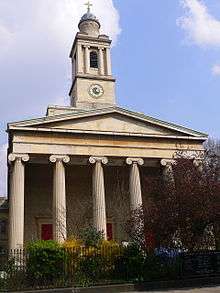St Peter's Church, Eaton Square
| St. Peter's Church, Eaton Square | |
|---|---|
 | |
| Location |
Eaton Square Belgravia, London |
| Country | United Kingdom |
| Denomination | Church of England |
| Churchmanship | Anglo-Catholic |
| Architecture | |
| Status | Parish church |
| Functional status | Active |
| Architect(s) | Henry Hakewill |
| Style | Neoclassical |
| Administration | |
| Diocese | London |
| Clergy | |
| Vicar(s) | Ralph Williamson |
St. Peter's Church, Eaton Square is a large Church of England church which stands at the east end of Eaton Square, Belgravia, London. On 19 October 1991 The Times newspaper wrote "St Peter’s must now rank as one of the most beautiful churches in London". It is a Grade II* listed building.[1]
St. Peter's was designed in a classical style by the architect Henry Hakewill, and featured a six-columned Ionic portico and a clock tower. It was built between 1824 and 1827 during the first development of Eaton Square. The interior was, as was common at the time, a severe preaching box, with the organ and choir at the west end. This building burnt down and was rebuilt from Hakewill's drawings by one of his sons.[2] The original church was a Commissioners' church, receiving a grant from the Church Building Commission towards its cost. The full cost of the church was £22,427 (equivalent to £1,750,000 in 2015),[3] towards which the Commission paid £5,556.[4]

In 1875 the church was enlarged by Sir Arthur Blomfield, and reordered to provide a chancel at the east end in the Romanesque style, although externally the changes remained faithful to the original classical style. From its founding St Peter's, Eaton Square, Pimlico was usually recorded as St Peter's, Pimlico (at least prior to 1878).[5][6]
In 1987 an anti-Catholic arsonist set fire to the east end, in the mistaken belief that the Grade II-listed building was a Roman Catholic chapel. Within hours the entire church was engulfed, and the following day, by which time the embers had cooled, only the Georgian shell of the building remained: although the fire was out, the church was roofless, with most of its furnishings destroyed.[7]
The church needed total rebuilding. The Braithwaite Partnership were appointed as architects by the church authorities to completely redesign the building with a new and simpler interior, also incorporating within the space a vicarage, offices, flats for a curate, verger and music director, a meeting hall, nursery school rooms and a large playroom for the church's youth club.
Work on the new church began at Easter 1990 and was completed in 1991. It retained the grand Georgian portico but beyond that the interior is described by visitors as clean, bright and modern.[8] The choir and organ are again located at the west end, as in the 1827 plan, although the fittings are thoroughly modern. The church is accessible, with disabled toilets available. Behind the altar is an apse that is decorated entirely with gold mosaic. Around the side of the apse, part of the 1873 sanctuary which survived the fire can be seen, and also a side chapel now used as the vestry office, complete with stained glass.
See also
References
- ↑ Images of England: St Peter's Church, Eaton Square, English Heritage, retrieved 9 May 2010
- ↑ Dictionary of National Biography (OUP, 1975)
- ↑ UK CPI inflation numbers based on data available from Gregory Clark (2016), "The Annual RPI and Average Earnings for Britain, 1209 to Present (New Series)" MeasuringWorth.
- ↑ Port, M. H. (2006), 600 New Churches: The Church Building Commission 1818-1856 (2nd ed.), Reading: Spire Books, p. 328, ISBN 978-1-904965-08-4
- ↑ St. Peter's Church, Eaton Square, Pimlico. Drawn by Tho. H. Shepherd. Engraved by Thos. Dale. Published Oct. 13, 1827, Jones & Co. 3, Acton Place, Kingsland Place, London.
- ↑ 1878 Marriage License location St. Peter's Pimlico
- ↑ Sunday Times story, 25 February 1990
- ↑ Review
External links
- St. Peter's Eaton Square website
- The Braithwaite Partnership website
- St. Peter's Eaton Square Primary School
Coordinates: 51°29′52″N 0°08′57″W / 51.4978°N 0.1493°W